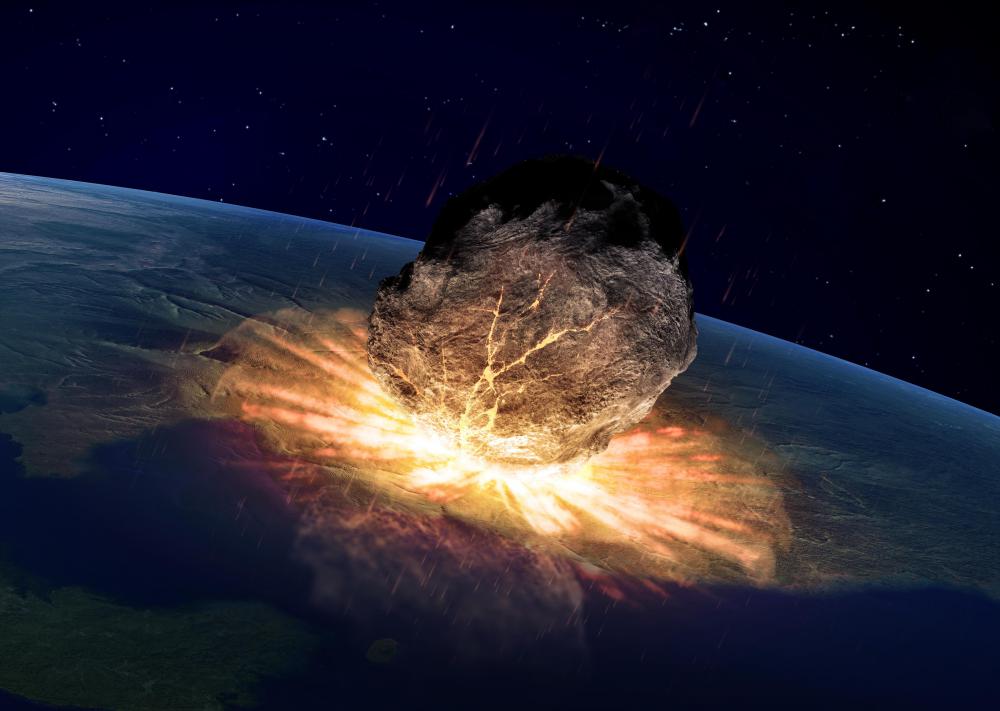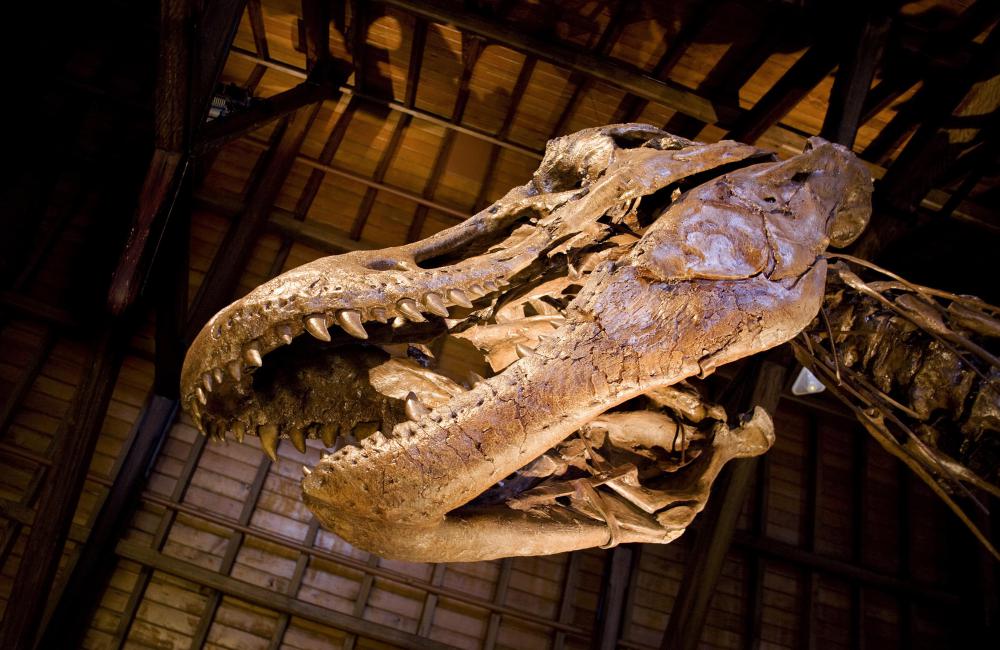At AllThingsNature, we're committed to delivering accurate, trustworthy information. Our expert-authored content is rigorously fact-checked and sourced from credible authorities. Discover how we uphold the highest standards in providing you with reliable knowledge.
What are Extinction Events?
Extinction events, or extinction-level events (ELE), are caused by global environmental disruptions that result in large percentages of marine and terrestrial species dying out.
Scientists report the background extinction rate — the normal rate that species die out — is approximately 2 - 5 marine and terrestrial families every million years. By contrast extinction events result in a drastic decline of species over a "brief" geological period of time.

The most famous extinction event was the Cretaceous-Tertiary 65.5 million years ago (mya) that wiped out 50 % of all species, including the families of dinosaurs. Also referred to as the KT event, from the German spelling of the geologic time periods, this extinction event was believed to be caused by an asteroid impact in what is now the Gulf of Mexico. This resulted in a cascade of environmental repercussions that lasted for an extended period of time and wiped out beasts that had reigned supreme for over 150 million years.

Although the KT event is the most well known extinction event, it is nearly insignificant compared to the Permian-Triassic extinction event of 252 mya. Also called the Great Dying, it wiped out 95% of all life on land and in sea. It is theorized that the one-million-year-period of volcanism that created the Siberian Trapps led to global warming, which might have raised ocean temperatures enough to trigger methane hydrate gasification, or release of methane gases from a frozen state in the seabeds. This would have compounded global warming, and this temperature increase, if sufficient, could have killed most life and contributed to stagnation of the thermohaline or global currents around the then-supercontinent of Pangea. Afterwards, fungi were the dominant terrestrial life form for several million years, making the Permian-Triassic ELE was the worst mass extinction event in history.
However there have been several mass extinction events, dating all the way back to 650 mya when stromatolites — structures formed by cyanobacteria -- and 70% of dominant Precambrian plant forms were eliminated. Other extinction events include:

488 mya: The Cambrian-Ordovician period saw a series of mass extinctions eliminating many brachiopods or mollusk-like creatures and conodonts which were marine creatures that resembled worms with cone-shaped teeth. Trilobites - tiny mud-filtering animals - were dramatically reduced.
440 - 450 mya: Two Ordovician-Silurian extinction events occurred, being the second most devastating extinction of marine life with more than 100 families of invertebrates eliminated. Glaciation of Gondwana that eventually made up part of the supercontinent of Pangea is suspected.

360 mya: The Devonian-Carboniferous extinction event - about 70% of marine species were eliminated. This included plankton, reef builders, all jawless fish and invertebrates. Some evidence exists that links this to another glacial period. Meteorite impacts may have also contributed.
252 mya: The Permian-Triassic extinction event, Earth's worst mass extinction eliminating 95% of all species. Evidence indicates mixed causations including the formation of Pangea combined with Siberian volcanism, greenhouse effect, and methane gasification increasing greenhouse gasses.
200 mya: The Triassic-Jurassic extinction event reduced 20% of all marine families as well as most pre-crocodilian archosaurs, most therapsids or mammal-like reptiles, and the remaining large amphibians. This extinction event is thought to have similar causations as the previous event, with massive volcanic eruptions of the Central Atlantic Magmatic Province (CAMP) leading to possible methane gasification.
65 mya: The Cretaceous-Tertiary (KT) extinction event that felled the dinosaurs, due to an asteroid impact.
Minor extinction events have also occurred and marine species are affected more often than terrestrial species. A study was put forward by Raup and Sepkoski that suggests an extinction event of some magnitude occurs about every 26 million years, leading to some to speculate about an unknown planet whose eccentric orbit passes through the Oort cloud every 26 million years or so, causing an increased likelihood of asteroid impacts. Others claim the 26-million-year cycles shown in the study are inaccurate.
According to recent studies, most biologists believe we are currently undergoing another great extinction event as natural habitats are being wiped out at an alarming rate. In the book, The Future of Life, author E.O. Wilson of Harvard University predicts 50% of all species will be extinct in 100 years. In 1998 the American Museum of Natural History conducted a survey and found most biologists agreed with this assessment. Studies conducted since by the International Union for Conservation of Nature and Natural Resources (IUCN) support Wilson's prediction, resulting in an international consensus among scientists.
Frequently Asked Questions
What is an extinction event?
An extinction event, also known as a mass extinction, is a rapid decrease in the biodiversity on Earth, where a significant percentage of all life forms become extinct in a relatively short geological period. These events are characterized by the loss of a vast number of species across multiple habitats and ecological niches.
How many major extinction events have occurred in Earth's history?
Earth's history has witnessed five major extinction events, often referred to as the "Big Five." These include the Ordovician-Silurian, Late Devonian, Permian-Triassic, Triassic-Jurassic, and Cretaceous-Paleogene extinctions. The Permian-Triassic event was the most severe, with about 96% of marine species and 70% of terrestrial vertebrate species becoming extinct.
What causes extinction events?
Extinction events can be triggered by a variety of factors, both extraterrestrial and terrestrial. These include catastrophic asteroid impacts, volcanic eruptions, climate change, sea level fluctuations, and more recently, human activities. Each event has its own complex set of causes that lead to widespread loss of life.
Are we currently experiencing an extinction event?
Many scientists believe we are in the midst of the sixth mass extinction, often called the Holocene or Anthropocene extinction. This event is primarily driven by human activities such as habitat destruction, pollution, overfishing, and climate change. Current extinction rates are estimated to be up to 1,000 times higher than the natural background rate.
What was the impact of the Cretaceous-Paleogene extinction event?
The Cretaceous-Paleogene extinction event, which occurred approximately 66 million years ago, is most famous for the demise of the dinosaurs, excluding the ancestors of modern birds. It is estimated that 75% of all species went extinct, paving the way for mammals to become the dominant land animals and eventually leading to the rise of human beings.
Can extinction events have long-term benefits for life on Earth?
While extinction events are catastrophic in the short term, they can lead to evolutionary innovation in the long term. By eliminating dominant species, they create ecological niches that surviving life forms can exploit, leading to adaptive radiation and the emergence of new species. This can increase biodiversity and drive the evolution of complex ecosystems.
AS FEATURED ON:
AS FEATURED ON:














Discussion Comments
@hidingplace - Many people argue that the life extinction event going on right now on this planet is largely due to mass chemical contamination, including pharmaceuticals and industrial chemicals, not to mention the additives and synthetic chemicals in our food.
If we are currently undergoing another great extinction event, will this be the first extinction event to be directly caused by humans? What are the listed causes of the current extinction event?
Post your comments